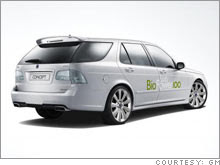AIST team developing Li-air capacitor-battery targeted for EVs
AIST team developing Li-air capacitor-battery targeted for EVs:
(Via Green Car Congress)A team from Japan’s AIST (National Institute of Advanced Industrial Science and Technology) reports on the development of a “lithium–air capacitor–battery based on a hybrid electrolyte” in a paper in the RSC journal Energy & Environmental Science.
The team had earlier investigated a hybrid electrolyte lithium–air battery, in which a lithium anode in a non-aqueous electrolyte and an air-catalytic cathode in an aqueous electrolyte solution were separated by a ceramic LISICON film. (Earlier post.)
As reported then, the lithium-air cell showed a continuous cathode discharge capacity of 50,000 mAh g-1 (per unit mass of the carbon, catalyst and binder). By comparison, conventional Li-ion batteries offer 120-150 mAh g-1 (active material + conduction assisting carbon + binder), and conventional lithium-air cells offer 700-3,000 mAh g-1.
In the present work, a capacitor electrode was put in the non-aqueous electrolyte solution as an additional cathode in parallel with the air catalytic cathode. The proposed lithium–air batteries with an additional capacitor cathode can successfully unite capacitor character and lithium–air battery character in one device which is now nominated as a “lithium–air capacitor–battery based on a hybrid electrolyte”.When high power is needed, the capacitor cathode would play the main role of peak power output; when high energy is demanded, the air catalytic cathode would display its high energy character. The adjustability of power output and energy output demonstrate that the proposed lithium–air capacitor–battery should be a promising power system for future electric vehicles.Resources
—Wang et al.
- Yonggang Wang, Ping He and Haoshen Zhou (2011) A lithium–air capacitor–battery based on a hybrid electrolyte. Energy Environ. Sci., DOI: 10.1039/C1EE02121D


Comments